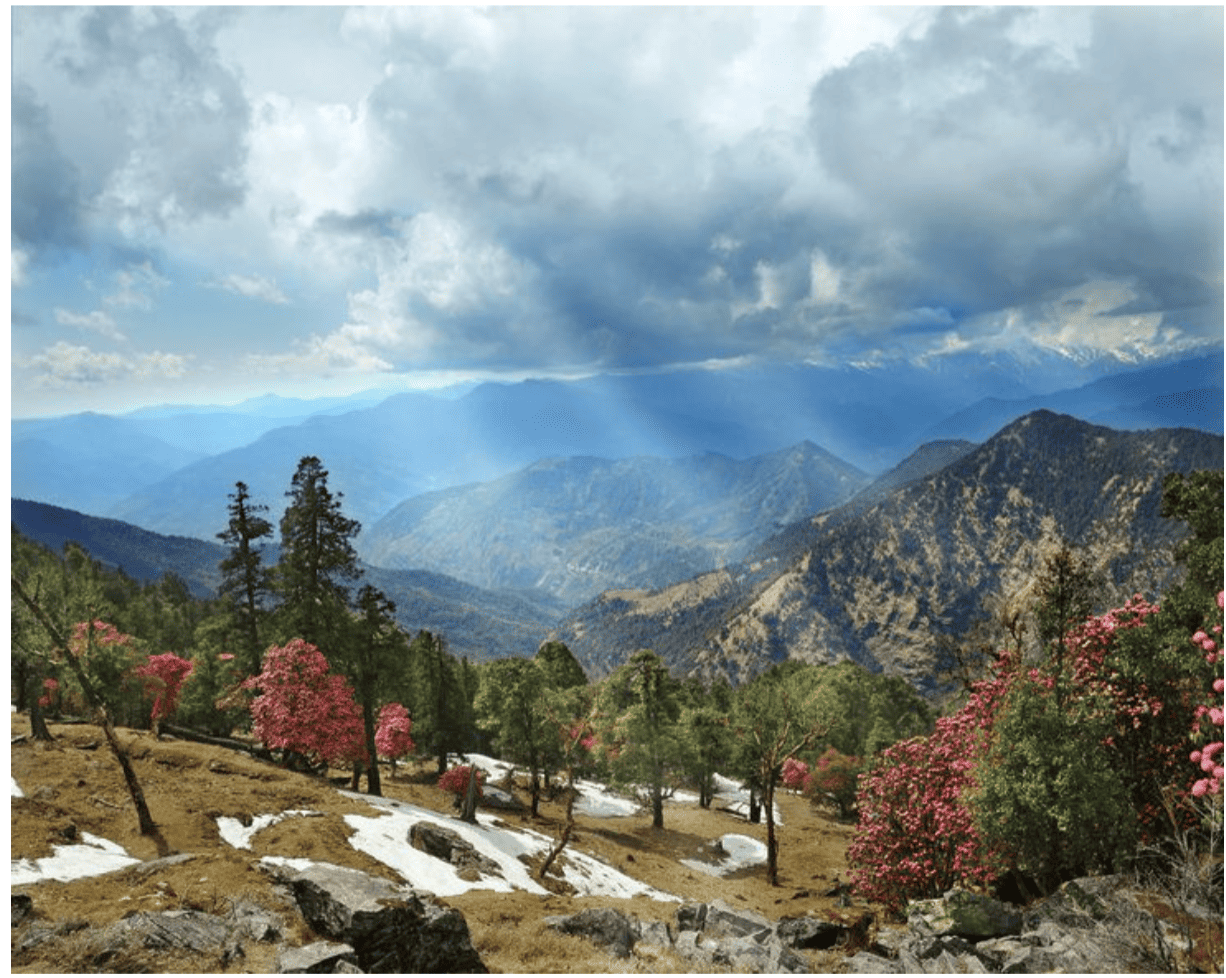Table of Contents
Why Choose Nag Tibba for Adventure?
Nag Tibba isn’t just a trek; it’s a journey that caters to adventurers of all levels. Its accessibility, along with the trail’s unique features, make it an ideal choice for beginners and seasoned trekkers. The trek’s distinctiveness lies in its panoramic views, diverse landscapes, and the sheer joy it brings to those who dare to explore it. For those new to trekking, Nag Tibba provides a gentle initiation into the world of adventure.
The trail’s moderate difficulty level ensures a challenging yet achievable experience. Meanwhile, seasoned trekkers will find the allure of Nag Tibba lies in its ever-changing scenery and the opportunity to test their skills on a trail that promises surprises at every turn.
Exploration of Uttarakhands Rooftop 2024: The Kuari Pass Trek Revealed
Trek Guide and Highlights
Embarking on an adventure is a thrilling pursuit that beckons to the hearts of avid explorers. In the vast realm of trekking destinations, Nag Tibba is a beacon for those seeking a perfect blend of challenge and natural beauty. This comprehensive guide aims to immerse you in the captivating world of the Nag Tibba trek, exploring its unique features, preparation tips, and the awe-inspiring experiences it offers.
Preparing for the Nag Tibba Trek
Like any adventure, getting ready is essential. Ensuring you have the right gear, equipment, and physical fitness is crucial for a successful trek. From sturdy hiking boots to layered clothing, every item in your backpack makes your Nag Tibba experience comfortable and enjoyable.
Physical preparation is equally important. Regular cardiovascular exercises, strength training, and flexibility exercises will enhance your endurance on the trail. Consider starting your fitness routine well in advance to make the most of your trekking experience.
Discover the magic of Nag Tibba Trek with The Searching Souls. Their experienced guides and tailor-made itineraries guarantee an exceptional trekking experience, making them the go-to choice for adventurers seeking the perfect blend of excitement and comfort.

The Scenic Trail: What to Expect
The Nag Tibba trail unfolds like a mesmerising story, with each step revealing new landscapes and natural wonders. From dense forests to expansive meadows, trekkers are treated to a visual feast that changes every turn. The trailhead begins at Pantwari, and as you ascend, the surroundings transform from lush greenery to rocky terrains, providing a diverse and enriching trekking experience.
One of the highlights of Nag Tibba is the mesmerising Oak and Deodar forests that carpet the trail. The rustling leaves and dappled sunlight create an enchanting atmosphere, offering trekkers not just a physical challenge but a sensory journey through nature.
Camping Essentials
Camping is an integral part of the Nag Tibba experience. Choosing the right camping spot and having the necessary gear ensures a cozy and secure night under the stars. The campsite at Nag Tibba offers a surreal view of the Garhwal Himalayas, making it a perfect spot to unwind after trekking.
Ensure your camping gear includes a sturdy tent, a warm sleeping bag, and a reliable camping stove for a comfortable night's rest. The joy of waking up amidst nature, with the first rays of the sun painting the sky, is an experience that adds immeasurable value to your trek.
Flora and Fauna Encounters
Nature enthusiasts will find themselves in paradise on the Nag Tibba trail. The region boasts a rich biodiversity, offering glimpses of diverse flora and fauna. From vibrant wildflowers to elusive wildlife, every step on the trek brings you closer to the wonders of the natural world.
Keep your eyes peeled for the Himalayan Monal, the state bird of Uttarakhand, and other bird species that inhabit the region. The diverse flora includes Rhododendrons, Oak, and Deodar trees, adding colour and fragrance to your trekking journey.

Keeping Memories Alive – Photography Advice
Preserving the memories of your Nag Tibba trek is as important as the journey itself. This section offers insights into the best photo opportunities along the trail and provides tips for capturing breathtaking landscapes and candid moments.
The golden hour during sunrise and sunset casts a warm glow over the mountains, creating a magical ambience. Don't forget to capture the camaraderie among fellow trekkers, the sense of accomplishment at each milestone, and the serenity of the Himalayan landscapes.
Local Culture and Cuisine
Nag Tibba isn’t just about the trek; it’s also an opportunity to connect with local communities. Immerse yourself in the unique culture of the region and savour local delicacies that add a flavorful touch to your adventure.
Interact with the locals, learn about their traditions, and join in a folk dance around the bonfire at the campsite. The warmth and hospitality of the people in the villages surrounding Nag Tibba add cultural richness to your trekking experience.
Weather Woes: Best Time to Visit
Understanding the seasonal variations on Nag Tibba is essential for planning a successful trek. We’ll guide you through the best months to visit, ensuring you experience the trek at its most vibrant and welcoming.
The trek is accessible throughout the year, but the best time to visit is from March to June and September to November. During these periods, the weather is pleasant, and the clear skies offer stunning views of the surrounding peaks.
Safety First: Guidelines for a Secure Trek
Adventure comes with its share of risks, and Nag Tibba is no exception. This section outlines essential safety measures, emergency protocols, and contacts to ensure a secure and worry-free trekking experience.
Before embarking on the trek:
- Check weather forecasts.
- Inform someone about your itinerary.
- Carry a basic first aid kit.
Knowing the emergency contact numbers and being aware of the nearest medical facilities will contribute to a safer trek.

The Summit: Nag Tibbas Peak Experience
Reaching the summit of Nag Tibba is the culmination of the trek, offering a panoramic view that leaves trekkers in awe. Personal narratives from those who conquered the peak will inspire and provide insights into this extraordinary moment. Standing at 9,915 feet, Nag Tibba delivers a 360-degree view of the snow-capped peaks of Swargarohini, Bandarpoonch, and Kala Nag. The sense of accomplishment and breathtaking scenery make the summit a highlight trekkers cherish.
Downhill Adventure: Return Journey
The descent from Nag Tibba is an adventure in itself. Navigating the trail safely and recovering post-trek are essential considerations. We’ll guide you through the return journey, ensuring a smooth and enjoyable experience. Take your time on the descent, savouring the landscapes you might have missed on the way up. Ensure you have enough water and snacks for the return journey, and consider a gentle stretching routine to alleviate any muscle soreness.
Testimonials from Fellow Trekkers
Real stories from fellow trekkers add a personal touch to the Nag Tibba experience. Discover the diverse experiences and insights of individuals who conquered the trek, providing a glimpse into this adventure’s impact on different lives. From solo travellers seeking solitude to groups of friends bonding over shared challenges, the testimonials capture the essence of Nag Tibba as a trek that transcends physical exertion, leaving a lasting impression on the hearts of those who undertake it.
Embarking on the Nag Tibba trek is more than a physical journey; it’s a soul-stirring adventure that leaves an indelible mark. From the breathtaking landscapes to the warm encounters with local communities, Nag Tibba offers a holistic trekking experience that beckons all nature enthusiasts. It’s time to lace up your boots and embrace the adventure that awaits on Nag Tibba.

FAQs About Nag Tibba Trek
Q1: How challenging is the Nag Tibba trek?
Nag Tibba is considered a moderately challenging trek, making it suitable for both beginners and experienced trekkers. The well-defined trail and gradual ascent provide a manageable yet exhilarating experience.
Q2: What gear is essential for the trek?
Essential gear for the Nag Tibba trek includes:
- Sturdy hiking boots.
- Layered clothing.
- A reliable backpack.
- A warm sleeping bag.
- A tent for camping.
- Additionally, carry a water bottle, first aid kit, and personal hygiene items.
Q3: Are there any age restrictions for Nag Tibba?
While there are no strict age restrictions, participants should be physically healthy. It’s advisable to consult with a healthcare professional before undertaking the trek, especially for individuals with pre-existing medical conditions.
Q4: Can I undertake the Nag Tibba trek solo?
Yes, the Nag Tibba trek can be undertaken solo. However, it’s recommended to inform someone about your itinerary, carry essential safety gear, and be well-prepared for the challenges of trekking alone.
Q5: How do I book a guided trek to Nag Tibba?
Several trekking agencies offer guided treks to Nag Tibba. Research and choose a reputable agency with experienced guides. Booking in advance is advisable, especially during peak trekking seasons.
Thanks for taking the time to read this article. I hope this post has given you the information you need. If you have any recommendations, tips or advice, I would love for you to share them in the comment section below!
This post may contain affiliate links, meaning we may receive a commission at no extra cost if you purchase through a link. Please see our full disclosure for further information.
Check out my Instagram page or join the Truly Expat Facebook group.
Pin it for later.

Do you want to read more like this?
Embracing the Indian Summer: Compelling Reasons to Travel from the USA to India in 2024
Discover the Best Things to Do in Lonavala in 2024- Your Ultimate Guide to Local Attractions




